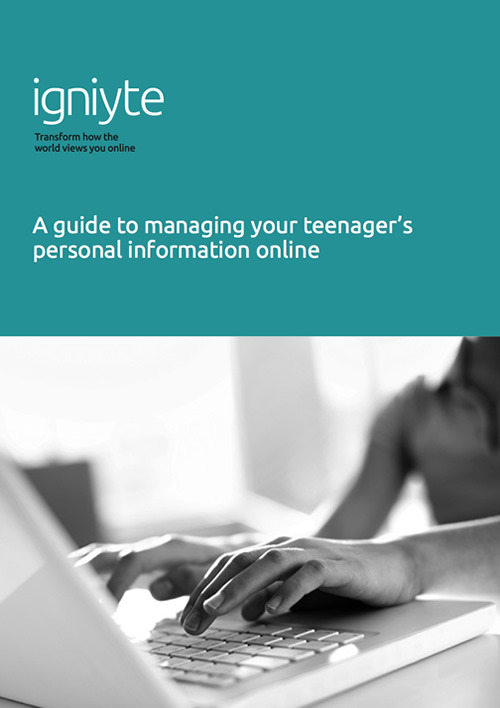Teenage privacy: Managing your teenager’s personal information online
We all want the best for our children, and maintaining a positive digital profile is essential for a generation who have grown up using the web. But when it comes to helping teenagers find their way in the online world, it can be hard for parents to be sure of the best approach. Teenage privacy – how can you help your family?
Learning how to use the Internet responsibly and safely is a key life skill. Parents and carers play a vital role in educating children and young people about the benefits and drawbacks of electronic and social media. And, with a growing number of employers using the Internet to find information about prospective candidates, it is becoming increasingly important to support your teenager in building a suitable digital profile. A positive online presence can improve a young person’s chances of securing a place at college or university, and will help with future career opportunities.
This guide to managing teenage privacy is designed to equip you with the information you need to help empower your teenager to use the Internet in a productive way. It offers helpful advice about teenage privacy and how to build a positive online presence, it discusses e-safety, and explains why online reputation management is a reality for teenagers today.

Stat
Two in ten children aged between 8 and 12 years, who use the Internet at home, say they have a profile on social networking sites such as Facebook.
Ofcom Children and Parents – Media Use and Attitudes Report (October 2013)
Fact
Under a US law, the Children’s Online Privacy Protection Act (COPPA), all major social networks require users to be at least 13 years old.
- Teens are sharing more information about themselves on social media sites than they did in the past.
- 24% of online teens use Twitter, up from 16% in 2011.
- The typical teen Facebook user has 300 friends, while the typical teen Twitter user has 79 followers.
- 60% of teen Facebook users keep their profiles private, and most report high levels of confidence in their ability to manage their settings.
- Teens take steps to shape their reputation, manage their networks, and mask information they do not want others to know.
- 59% have deleted or edited something that they posted in the past.
- 74% of teen social media users have deleted people from their network or friends list.
- 58% have blocked people on social media sites.
- Teens are considerably more likely to report positive online experiences than negative ones.
- 52% of teens say they have had an experience online that made them feel good about themselves. Teens, Social Media, and Privacy – PEW Internet PEW Internet is a fact tank which provides information on the issues, attitudes and trends shaping America and the world.
Online profile
How to help your teenager build a positive online profile:
The growth of the Internet has made it very easy to find information about a person online. The more information you post, the more likely you are to show up in search results. Your teenager is no different.
Teenage online reputation is largely determined by what they post online, as well as what their peers post. It is essential they learn how to manage their profiles responsibly.
Help them to understand their digital footprint – the trail they leave behind every time they use the Internet. Explain the consequences of reacting too quickly online and making ill-advised posts.
Set clear guidelines and spell out the ‘dos and don’ts’ of communicating online. The golden rule of making posts, comments and chatting online is that you should only say something that you would be willing to say to someone in person.
Topics which are not acceptable to chat or post about, such as drugs and alcohol, should be avoided. Deleting posts, images and comments after the event may be too late if others have already circulated the content.
Online content has the potential to go viral at the speed of light, and once this happens your teenager has lost control.
So how can you help with teenage privacy?
Encourage them to create an online profile that reflects who they are, their interests, hobbies and experiences. Inspire them to set up a social media presence across platforms such as LinkedIn, Twitter and Google+.
Assist them in purchasing their own domain name e.g. YourName. com, and in creating their own personal blog or website.
Explain that the images of themselves they use online, in any scenario, should be ones they would want a potential recruiter or admissions officer to see. Advise them to remove unwanted tags on unsuitable posts or images.

Fact
The social media craze NekNomination, which encourages people to drink alcohol before posting an image or video of the stunt online, hit the headlines in February 2014, after apparently claiming the lives of teenagers in the UK and Ireland.
How to do an audit of your teenager’s online profile:
Understand how your teenager is presenting themselves online by following these key steps:
- Search for your teenager’s name online, along with their home town, school or club, and see what appears – if any of their social media posts show up in the searches, advise them to change their privacy settings to ‘friends’ only.
- Assess what different types of devices your teenager has access to, for example, games consoles, computers, laptops, tablets, mobile phones and web cams – ensure these are securely managed.
- Know which social networking sites your teenager is using, for example, Facebook, Twitter, Instagram and online chat – help them to optimise the privacy and security settings.
Case Study: Negative Content on Page One
An apprentice applied for a role with an employment agency. The candidate interviewed well and the human resources manager recommended her for the post. Subsequently, the managing director of the company carried out an online search for the apprentice’s name. The search results revealed a different story. Inappropriate images, probably meant only for the apprentice’s close circle of friends, were displayed all over page one of Google. After seeing the images the company changed its mind and decided not to offer the apprentice a position after all.
“One in five employers use social networking sites to research job candidates, and close to 59% of them are influenced by your online presence.”
Career Builder
Case Study: Lack of Visible Content
A college graduate with an excellent set of credentials applied for a role with a digital marketing agency. The graduate’s CV indicated that he had an active interest in online marketing. When the agency searched for his name on the Internet nothing appeared in the search results. The agency was looking to see if the graduate had developed a digital CV. However, a visible lack of presence online immediately rang alarm bells with the agency. By neglecting to promote himself online, the graduate had failed to win the confidence of the agency. In the highly competitive world of digital media, it is a pre-requisite for anyone working in the industry to use social media and other online outlets to demonstrate their skills and expertise.
“In the next ten years, resumes will be less common, and your online presence will become what your resume is today, at all types and sizes of companies.”
Dan Schawbel, Forbes
How to set your privacy settings
Igniyte’s tips for teenagers
All of the major social media sites can be set to control both who views the content, and who has the ability to post onto your profile. Having an open profile on Facebook may enable you to gain more friends, but it may also leave you open to negative comments.
Changing your privacy settings reduces the visibility of your profile in the search engines. Protect yourself online by optimising your privacy settings and limit the number of people posting to your profile. Here are a few hints to help you.
Facebook
Set your privacy settings so that only ‘friends’ see your content and can post on your wall. Disable your location settings.
Twitter
Set your profile so that only ‘followers’ see your tweets. Turn off your location settings and clear information about where you have been in the past.
LinkedIn
Set your profile so that only your confirmed contacts can see your updates and full profile.
YouTube
Set your account so that no one can post comments on any videos you upload. You can also set videos to be seen only by you and prevent them from appearing in search results.
Instagram
Instagram is a photo and video sharing social network. Set your privacy settings to make your posts private, so only approved followers can see them.
Pinterest
Pinterest is a pinboard-style photo sharing website. In account settings switch on the ‘search privacy’ button to prevent search engines such as Google from showing your profile in search results.
Flickr
Flickr is an image and video sharing social network. Use the privacy settings to control who sees your profile. Set your geo preferences so you select who sees the location of your photos.
Myspace
Myspace is a social network with a music emphasis. Set your privacy settings to ‘restricted’ to control who views your profile. Hide your ‘mix’ from public view by selecting the lock symbol.
SnapChat
Snapchat is a photo messaging application. Set privacy settings so the Snaps and Stories you send are only seen by your friends.
Vimeo
Vimeo is a video sharing website. Set your privacy settings so you choose who can see and comment on your videos. You can also control who embeds your video, and from where.
Google+
Google+ combines all of Google’s services with social networking. The site has introduced special default settings for teenagers. Set your profile sharing to ‘my circles’ for personal information.
Skype
Skype is a video and voice calling application. Set your preferences to private and only authorise people you want to speak to.
Blogs and websites
Ensure comments are switched off or set to ‘approval by you’ in any blog posts or articles you write. Popular sites such as www.blogger.com and www.wordpress.com allow you to control who can and cannot view your blog.
Tip
When setting up a new profile, ensure the name that you are trying to create content for is used as the name of the account, e.g. for the name Janice Deacon, set up the Twitter account with “Janice Deacon” as the profile. Add numbers and hyphens to account names if the name has already been taken.
Future prospects
How online reputation impacts on your teenager’s education and career.
Online reputation management is becoming increasingly important for young people. The rise of social media has created opportunities, but also problems when the content is less than positive. Being aware of the consequences of a negative online presence is fundamental to a young person’s future education and career prospects.
Recruiters, teachers and college and university admission officers are increasingly searching online for information about prospective candidates and students before they interview them. If they find inappropriate content or images published on social networking sites or blogs, they may not even consider the applicant for the role.
Similarly, a lack of presence online can be equally disadvantageous for a young person, who may be discounted for not showing an active interest in their chosen field. What does it say about a candidate who claims they are interested in online marketing, but has no presence online?
A well written CV is one of the best tools a young person can have in helping them succeed in moving into further education and securing a job.
Encourage your teenager to start building an online CV as early as possible. If your teenager already has an established online presence, encourage them to build on this in a positive way. The more they develop their profile with relevant content and links to industry sites, the easier it will be for college and university admissions officers and potential employers to find them.
Fact
An Internet craze known as the ‘SelfieOlympics’, has taken the concept of the ‘selfie’ a step further by encouraging people to share bizarre and, in some cases, dangerous images of themselves online.
“The inclusion of key e-safety messages at each Key Stage is paramount in ensuring that all children are given the opportunity to become safe and responsible digital citizens. We know from our work in schools that pushing the boundaries and risk taking are behaviours common to teens, and it is vital that they receive continued support and education on e-safety topics.” Childnet International
Stat
A recent survey undertaken by Kaplan – a world leader in test prep – found that 29% of college admissions officers from the top national, regional and liberal arts colleges and universities in the US have ‘Googled’ candidates, while 31% have visited a student’s Facebook or other social media profile.
How to promote yourself online
Igniyte’s tips for teenagers
Having a good online reputation is essential in today’s increasingly competitive marketplace. How a job or university applicant is perceived online often has more impact than the more traditional CV.
Build a digital profile to reflect your interests, skills and aspirations by following these key steps:
- Establish your own distinct online profile using social media sites such as LinkedIn, Twitter, Facebook, Instagram and Pinterest to showcase your education, hobbies and skills.
- Follow individuals and organisations that inspire you, and post to industry and subject-related blogs.
- Link to authority websites such as newspapers and government sites, and subscribe to relevant online groups.
- Develop your own blog and write posts about your interests and aspirations. Be careful about what you write.
Remember, no swearing or hateful comments, and be aware that strong opinions may come back to haunt you. - Create your own website using platforms such as WordPress and Blogger. A homepage of a website www.yourname.com will usually rank for a search term of “your name” as long as the website is optimised and there are not too many other people with the same name. There is no need to make your site complex – stick to four or five main pages and a blog section.
- Advertise your skills and experience online by posting your CV on social media sites such as LinkedIn. Create a video CV and post it on video sharing sites such as YouTube and Vimeo. Remember to set privacy settings so that you are in control of comments and whether the content is public or private.
- Maintain a positive online presence by regularly adding new and fresh content to your online profiles.
Protecting identity
Why it is important to help your teenager protect their online identity:
Children and young people use the Internet to learn, communicate, create, socialise and to have fun. Through it they have access to a greater sense of community and the wider world. It is important to encourage them to share their thoughts in a considered and thoughtful way.
However, the rise of social media has made it easier for young people to be exploited. In October 2013, Facebook announced plans that impacted on millions of young people aged between 13 and 17, who now have the choice to post comments and images publicly. Previously their posts could only be seen by ‘friends’ or ‘friends of friends’.
Adding the option to share publicly, brings Facebook in line with other social media sites popular with teenagers. It highlights the growing need for young people to manage their privacy settings and control what they publish online.
According to Facebook, the National Crime Agency believes the changes will “help young people understand the need to manage their privacy settings carefully and to control who they share their information with.”
Teenagers will ultimately make mistakes online and the likelihood is that they will not realise the consequence of their actions, so guidance is necessary.
Stat
76% of teens are very or somewhat concerned about the privacy of their personal information being harmed by their online activity.
Family Online Safety Institute (November 2013)
Fact
In 2013, ChildLine launched Zipit – an app to help teenagers refuse requests for explicit images of themselves. The app offers users a choice of “witty responses” to send instead. It is free to download and is available for Android, Apple and BlackBerry smartphones and iPod touch.
So how can you help?
It is just as important for you to act as a ‘role model’ online as it is offline. Discuss e-safety with your teenager, just as you would any other risks or dangers.
-
- Talk to them about the advantages and the hazards of communicating online.
- Make sure they know how to set the privacy settings on social media websites such as Facebook and Twitter.
- Privacy settings should be set to ‘friends only’ so that their content has a limited audience.
- Establish basic rules for Internet use and support them in keeping their social media profiles clean.
- Advise them not to share ‘private’ information such as phone numbers and personal details publicly.
- Advise them to turn off the GPS ‘check-ins’ on their mobile devices so they cannot be pinpointed at any time.
- Be aware of online dangers such as cyberbullying, trolling or sexting. Ensure your teenager knows how to block someone online and how to report an online incident should one occur.
- Monitor how many hours your teenager spends on the Internet. For younger children, place computers and consoles in a family area of the home to prevent excessive or inappropriate usage. Set up parental controls.
Fact
Although many schools adhere to guidelines issued by Ofsted (the UK’s Offices for Standards in Education, Children’s Services and Skills) with regards to e-safety provision in schools, there is no guarantee that e-safety is embedded within the curriculum. Campaigners are calling for the Government to review sex and relationship guidance for schools.
“We can improve the safety of children and young people online by empowering children, parents, guardians, educators and peers to identify and deal with harmful content on computers, the Internet and mobile phones, and how to use technology both safely and responsibly, and by making available easy to use, adjustable tools to manage access and content.”
Internet Society
Stat
According to a new survey, The Social Age, by knowthenet.org, ‘when children reach 13 – their social maturity – they first try services like SnapChat and Ask FM and will try sexting for the first time.’
How to deal with online issues
Igniyte’s tips for teenagers
Cyberbullying is one of the most commonly faced issues experienced by teenagers online. If you are facing an issue online, such as false postings, threats, abusive comments, malicious gossip, offensive images, harassment or even stolen identity, speak to a parent or another adult.
Here are some ways to help protect yourself online:
- Ensure your privacy settings are optimised. Remember, if your profile is public anyone can see what you post or even find out your location.
- Never share logins, even with close friends.
- If someone tags you in an unflattering post or picture on social media, these can be removed on most sites.
- Report abuse by using the report links on social media sites and tell parents and teachers.
- If someone is bothering you online, block them from seeing your profile on social media sites.
- If someone posts false or abusive content about you online, ask them to remove it, or contact the website directly. Check the website’s terms and conditions to see if any of the content contravenes their content policy.
- If the content is defamatory, it is worth submitting this to Google’s Removal Tool for Google owned platforms.
- Make sure that you own your social media profiles – check Google for what is ranking for your own name.
- Most schools have an anti-bullying policy, and some a social media policy, so speak to a teacher directly, or ask a parent or another adult to contact the school.
- Set up Google Alerts for your own name – this will alert you if anyone is posting content about you.
- Safeguard yourself from stolen identity by selecting your passwords carefully – using a combination of numbers and letters – and never share your passwords.
- If someone makes a threat to you on the Internet they may be committing a crime – report any requests that make you feel uncomfortable, or cause you distress, to the local authorities and to the police.
Tip
Jailbreaking – is it worth the risk?
Jailbreaking is a term used to describe the unlocking of a device. It allow users to access areas of the device not normally permitted by the manufacturer. It is a particularly common practice with iPads and iPhones. While not technically illegal, anyone attempting to jailbreak a device should be aware of the consequences – all of which place your data and device at risk:
- The warranty on the device may become void
- The device may be more susceptible to viruses
- The device may stop functioning
Teenage privacy – summary
Igniyte’s key factors to managing your teenager’s personal information online:
- Educate yourself about the Internet and discuss e-safety with your teenager.
- Establish basic rules for Internet use.
- Ensure your teenager’s digital assets are secure, with privacy settings and filters optimised.
- Help your teenager to understand their digital footprint, and advise them never to post when angry or upset.
- Encourage your teenager to behave responsibly online, and have respect for others.
- Advise your teenager to keep their social media sites clean, and to remove any unwanted tags on images or posts.
- Help your teenager to establish and maintain a positive online profile – one which they would be happy for teachers and potential recruiters to view.
- Help your teenager to control their digital assets, and advise them never to share passwords.
- Support your teenager if they are facing negative content, and make sure they know how to report online abuse.
- Contact any websites that feature defamatory content to ask them to remove it.
- Use the Google Removal Tool to attempt to remove defamatory content from the search results if the websites themselves do not help you with removal.
“Many students are becoming more cautious about what they post, and also savvier about strengthening privacy settings and circumventing search.”
Christine Brown, Executive Director of College Admissions programs, Kaplan Test Prep
Stat
A UK study of young people’s attitudes toward online rights and responsibilities – Safer Internet Day ‘Have Your Say’ Report (February 2013) – found that “over half (53%) of 11 to 19 year olds would tell a friend if something upset or worried them online, and for 14 to 19 year olds, friends are the people they are most likely to turn to. Older siblings play an important role in supporting this age group too; 27% of 11 to 19 year olds said they would turn to an older sibling.”




